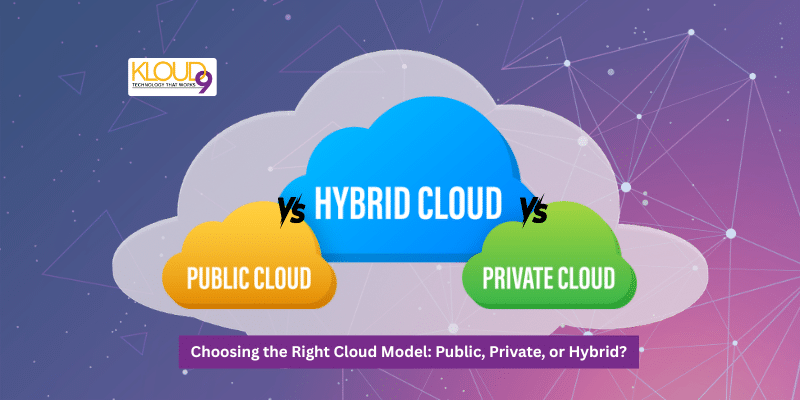The cloud is more than a technical fad; the cloud is an opportunity that will make your business agile or break it. Everything is available, although deciding which one is not the question of whether or not to move to the cloud; it is which model. Will it be a public, a private, or a hybrid? The two routes are associated with a series of advantages and drawbacks. How about we helpiness up in the air and with the maximum possible need?
The broad classification of cloud models can be summarised into three:
- Public Cloud
- Private Cloud
- Hybrid Cloud
The models have various degrees of control, security, and flexibility.
1. Public Cloud: Owning Power without the Pain of Ownership
A public cloud comprises a computing segment managed by third-party providers (such as AWS, Microsoft Azure, or Google Cloud Platform) to provide computing means (such as servers and storage) via the Internet.
Advantages:
- Minuscule scale: Scale up or down resources, as well as demand.
- Economical: No requirement for hardware making or maintenance. You pay as you go.
- Fast Deployment: A new application that can be installed within a few minutes.
Drawbacks:
- Restricted Control: This is more like renting space and resources than actual ownership of them.
- Security and Compliance Issues: When you use multi-tenancy, your data will be shared with others on the same infrastructure, which is of concern to businesses in a regulated industry.
- Limitations on Deep Customisation: Providers incorporate a wide range of features but do not go into deep customisation.
Best For:
Small businesses, startups, and those organisations with unpredictable or varying requirements due to their need to utilise speed and scalability with a minimal initial outlay.
2. Private Cloud: Ultimate Control and Security
A private cloud is a computing environment that is used by a single organisation. The infrastructure may be delivered on-site or provided by a third-party supplier, but it will only serve a single client.
Advantages:
- Extreme Security and Compliance: This is because it is isolated and, therefore, suitable for businesses that require high data governance compliance.
- Total Customisation: Hardware and software setups can be customised to meet a specific business goal.
- Predictable Performance: No resource sharing, there is no performance interference.
Drawbacks:
- High cost: Infrastructure, maintenance, and IT professionals require significant capital investments.
- Not so scalable: It may need new hardware to be bought and configured.
- Lower Deployment: Installation and modifications are slow because it is controlled internally.
Best For:
Large companies, governmental organisations, institutions, and medical and financial institutions that work with confidential data and need to have certain control over their IT environment.
3. Is Hybrid Cloud the Best of Both Worlds?
A hybrid cloud is a variant of cloud where both public and private clouds are complemented with orchestration at an orchestration level. It allows easy transfer of data and applications between the two environments.
Advantages:
- Flexibility and Balance: Run sensitive workloads on private cloud and less sensitive workloads on public cloud to achieve security and cost efficiency, respectively.
- Business Continuity: An enhanced system of disaster recovery and backup of properties.
- Scalability & Control: Adopt the use of public cloud up to the rush of traffic and have a safe fallback on the private cloud.
Drawbacks:
- Complex Integration: This will need a well-built configuration and consistent monitoring to ensure smooth interactions between public and private components.
- Security Threats, In Case of Poor Management: Poorly secured integration can expose risks.
- Increased management cost: To manage two infrastructures, more managerial coverage and manpower with industry-specific knowledge may be needed.
Best For:
Midsize and large enterprises require a golden mean between flexibility and security, particularly those on legacy systems, which are already in existence.
How to Choose: Ask the Right Questions
To consider which cloud model is best for your business, you have to remember the following considerations:
1. What Are You Spending?
Lean teams are cost-effective in the public cloud, but a private cloud costs more. The cost of the hybrid cloud needs to be analysed.
2. What Security Do You Need?
Are you dealing with individual health records or money? If yes, then you are better off with the private or hybrid option.
3. And Where Do You Want To Be Scalability-Wise?
If you anticipate exponential growth, consider seeking public or hybrid financing, as you have a lot of leeway to grow without boundaries.
4. Do you Train In-House IT?
Internal teams have to be powerful in private and hybrid clouds, or managed service providers should be trusted.
5. Does It Matter to You to be Fast?
In situations where fast deployment is required, using a public cloud will provide the shortest turnaround time.
Industry Examples
- A Tech Startup that is developing a mobile app can afford a small deployment cost using a public cloud.
- A Hospital with sensitive patient data will be more prone to use a private cloud to ensure compliance with the HIPAA policies.
- A Big Box store with many touchpoints that could affect many customers may find a hybrid cloud acceptable. Key data is stored in an isolated storage pool, and the application that is exposed to the customer runs in a public cloud.
Future of Cloud Deployment and Trends
Current cloud trends are more motivated by the use of hybrid and multi-cloud solutions because companies desire flexibility, cost reduction, and vendor freedom. Cloud infrastructures are also adjusted to the integration of edge computing and AI, which makes the hybrid cloud model even more powerful.
In the meantime, the public cloud provider market actively develops security procedures and makes customizable packages available, thus getting nearer to the level of control of the private setups. The boundaries between the models are starting to become blurred; however, the necessity to get the right fit applies.
Conclusion
The cloud is not optional anymore; it is necessary. Depending on the convenience of using public, the protection of using a private, or the middle ground of using a hybrid model, your choice must meet your growth ambitions, security standards, and organisational capacity. It is not what is in fashion that should be followed, but rather what is right in terms of your business. Please don't make the cloud work; instead, make it work out. The correct decision concerning the cloud is what will make your infrastructure future-ready.


